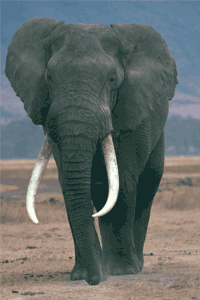
In Eastern Africa, a chain of magnificent volcanoes blister the face of the earth. Some are dead, others sleep, and one is very much alive. There is the Black Mountain, the Sacred Mountain, and the most famous of all, The Great White Mountain -- Mount Kilimanjaro. To ingenious tribes these legendary volcanoes are home of the Gods and known as the Mountains of Eden.
The largest and most impressive of all the animals that live on and around the Great White Mountain is the elephant. Images of these great beasts with Kilimanjaro’s white summit as the backdrop are world-renowned. Much less familiar are the shy and rarely seen elephants that dwell in the high forests.
In the past, elephants roamed freely up and down the mountain. Now they run a treacherous gauntlet as more and more of the slopes are cultivated. When tempted by the succulent crops, wild animals such as the elephants and monkey, face poisonous traps, snares and spears.
Elephants are not designed to scramble up and downs steep slopes. Deep ravines represent insurmountable barriers. The only way around is to climb up to the moors above the tree line. Here, in a haunt that conjures up images of goblins and elves, the elephants wander in a land of giant heathers, groundsels and lobelias.
Around the summit, the only signs of life are adventurous tourists, soaring lammegiers and white-necked ravens. No elephant has ever reached the top of Kilimanjaro (19,340 ft), although a skeleton was found at sixteen thousand feet. Bleached bones provide proof, but why would one of these great beasts ascend so far up the Great White Mountain?
One explanation is minerals. Salts are plentiful on the plains but scarce in the forest. The land in between is increasingly populated. Perhaps a mineral deficient and desperate elephant too scared to travel down to the savannah was forced to trudge upwards. It is also possible that poachers with guns drove the beast to such great heights.
These mighty beast will lead us on a journey of exploration, adventure, and revelation as we follow their footsteps up the Great White Mountain, Kilimanjaro.

